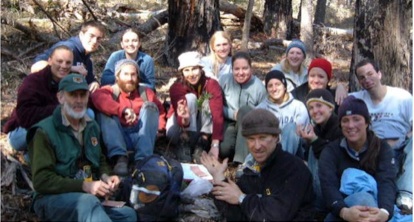I met Five Capitals in the work of Prof. Jules Pretty at Essex Uni who was using it as a model for development projects (whatever happened to all his great development material? Thanks for nothing, over-zealous university IT administrators.)
It was developed by Forum for the Future as a large-scale model for a sustainable society. But it works beautifully on the smaller scale of groups and communities as well.
It excited me then, and it’s stuck with me, because it’s so obviously superior to the standard Triple Bottom Line model, with its three arms of ecology, society and economy.
You can read the standard version of Five Capitals on the Forum for the Future, but I interpret it like this:
A community is healthy and sustainable when five kinds of capital are present in people’s lives:
1) Natural capital = the quality and productivity of the natural environment.
2) Infrastructure = quality of housing, accessible transport, medical and welfare services, food distribution systems, communication infrastructure.
3) Financial capital = access to liquidity, fair wages.
4) Social capital = the web of voluntary organisations like trade unions, clubs and societies, play groups, Landcare groups, and so on.
5) Individual capital = the life skills, social skills and technical skills that give people the self-efficacy to lead autonomous lives.
In my book I wrote “There are rarely silver bullets in this kind of work. Instead, change is more like a pattern.” Five Capitals illuminates what kind of pattern that might be.
One thing it does is explain why programs based only one kind of capital fail to achieve much progress, even when they are exceptionally well designed and well received. For example, the focus on indigenous development in Australia has been overwhelmingly on money + housing + services. That’s only two kinds of capital. Which is why a program that develops life skills (individual capital) like the Family Wellness Program at Yarrabah is so important, and it also explains why that program alone can’t produce a hoped-for transformation of community well-being.
Five Capitals throws a challenge out to all of us. We tend to focus exclusively on building one kind of capital. Often we’re only delivering a health service, or a financial incentive program, or restoring a river. The challenge is – can we build two or more capitals into one project? Could we, for example, build emotional life skills while also restoring a riparian corridor? Could we provide housing and also a small grants program for local vegetable production?
I was inspired a few years ago to hear a story from the NSW south coast, about a youth leadership project called Growing Our Future Leaders, funded by the Southern Rivers CMA.
David Newell, a catchment officer at SRCMA, pulled together the funding for a first-time partnership between the Pathways Foundation, The Crossing Land Education Trust, and the Bournda Environmental Education Centre. It was quite an innovation for the CMA, which, like every other NRM organisation, had been more comfortable doing on-ground work like fencing creeks and planting tree corridors.
In all, the project took about 40 young people on camps that mixed personal development, environmental learning, and physical work on Landcare sites: a potentially transforming experience at a pivotal moment in their lives.
David’s thinking was: “If you can provide right kind of experience, not too much head, plenty of hands, and a bit of heart, then young people grow into it and infect each other with enthusiasm.” Which is what happened.
This was not just innovative, it was beautiful because it combined three capitals: individual capital, environmental capital, and the social capital represented by the three organisations. Imagine if it provided a pathway to employment or start-up grants…that would be a fourth capital. And then, if it left behind some permanent infrastructure, that would be all five!

A Growing Our Future Leaders camp on the NSW south coast.
Community building, Innovation, Strategy
Five Capitals – an underused, and useful, model for community wellness and sustainability
